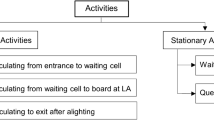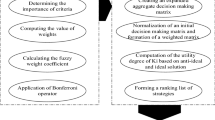Abstract
High volume bus facilities range from on-street facilities to dedicated Bus Rapid Transit (BRT) facilities. The aim of this study is to better understand performance by directly relating critical stop bus capacity to quality of service (QOS), which measures performance from the passengers’ and operator’s perspectives. The US transit capacity and quality of service manual methodology estimates facility bus capacity based on critical stop operation using a failure rate approach. However, this approach is inaccurate under high volume conditions and the failure rate is a difficult measure to prescribe and to interpret. This research provides an improved understanding of operation by instead considering bus upstream average waiting time to measure capacity and QOS performance, because it is experienced directly by passengers and is an indicator of the impact upon general traffic. A fundamental microscopic simulation model is developed with many bus stop operational aspects occurring stochastically, including upstream arrivals. An empirical upstream average waiting time model is calibrated for five bus stop scenarios including BRT and on-street conditions. This is then used to determine working capacity based on QOS threshold upstream average waiting time. Assigning a worse threshold gives diminishing returns in working capacity, particularly for waiting times beyond 60 s. For an assigned threshold, as loading area processing time reduces, working capacity increases more markedly. This demonstrates that BRT stations are more productive than general on-street bus stops. An example shows that a policy decision exists for the operator as to which QOS threshold to accept in balance with working capacity that suits the desired schedule. It is also discussed that the model enables the operator to evaluate the impact of design or operational changes as well as timetable changes on capacity and QOS.




Similar content being viewed by others
References
Alpkokin P, Ergun M (2012) Istanbul Metrobüs: first intercontinental bus rapid transit. J Transp Geogr 24:58–66
Babalik-Sutcliffe E, Cengiz EC (2015) Bus Rapid Transit system in Istanbul: a success story or flawed planning decision? Transp Rev 35(6):792–813
Dodero AL, dos Santos da Rocha PM, Hernandez JJ, Cezero A (2014) Evaluating improvements in Bus Rapid Transit in Mexico City, Mexico. How feasible is it to improve a consolidated system? Transp Res Rec J Transp Res Board 2451:88–96
Godavarthi GR, Chalumuri RS, Velmurugun S (2014) Measuring the performance of Bus Rapid-Transit corridors based on volume by capacity ratio. J Transp Eng 140(10):−1–1
Hao YU, Qiuxiang C (2013) Planning of BRT exclusive lane and analysis of passenger capacity. In: Proceedings of the fourth international conference on transportation engineering. American society of civil engineers, Washington
Hidalgo D, Lleras G, Hernández E (2013) Methodology for calculating passenger capacity in bus rapid transit systems: application to the TransMilenio system in Bogotá, Colombia. Res Transp Econ 39:139–142
Kittelson & Associates, Inc., Parsons Brinckerhoff, KFH Group, Inc., Texas A&M Transportation Institute, Arup (2003) TCRP Report 100: transit capacity and quality of service manual, 2nd edn. The National Academies of Sciences, Engineering, and Medicine, Washington
Kittelson & Associates, Inc., Parsons Brinckerhoff, KFH Group, Inc., Texas A&M Transportation Institute, Arup (2013) TCRP Report 165: transit capacity and quality of service manual, 3rd edn. The National Academies of Sciences, Engineering, and Medicine, Washington
Lee W (2004) An investigation into dwell times at Mater Hill Busway Station. Dissertation, Queensland University of Technology
Lindau LA, Pereira BM, de Castilho RA, Diógenes MC, Maldonado JCH (2013) Exploring the performance limit of a single lane per direction Bus Rapid Transit system (BRT). In: Transportation research board 92nd annual meeting compendium of papers. The National Academies of Sciences, Engineering, and Medicine, Washington
Ortiz M, Bocajero JP (2014) TransMilenio BRT capacity determination using a microsimulation model in VISSIM. In: Transportation research board 93rd annual meeting compendium of papers. National Academy of Science, Washington
Raj G, Sekhar CR, Velmurugan S (2013) Micro simulation based performance evaluation of Delhi Bus Rapid Transit corridor. Soc Behav Sci 104:825–834
Reilly J, Aros-Vera F (2013) Estimating capacity of high volume Bus Rapid Transit stations. In: Transportation research board 92nd annual meeting compendium of papers. The National Academies of Sciences, Engineering, and Medicine, Washington
Sharma HK, Swami BL (2013) Performance enhancement and congestion reduction at busy signalized at-grade intersection with Bus Rapid Transit corridor and mixed traffic in India. In: Proceedings of the third international conference on urban public transportation systems. American Society of Civil Engineers, Washington
Sharma HK, Swami M, Swami BL (2012) Optimizing performance of at-grade intersection with Bus Rapid Transit corridor and heterogeneous traffic. Int J Transp Sci Technol 1(2):131–146
St Jacques K, Levinson HS (1997) TCRP Report 26: operational analysis of bus lanes on arterials. The National Academies of Sciences, Engineering, and Medicine, Washington
Transportation Research Board of the National Academies (1994) Highway capacity manual. The National Academy of Sciences, Washington
Transportation Research Board of the National Academies (2010) HCM2010 highway capacity manual. The National Academy of Sciences, Washington
Widanapathiranage R, Bunker JM, Bhaskar A (2013) A microscopic simulation model to estimate Bus Rapid Transit station bus capacity. In: Australasian transport research forum 2013 proceedings. Australian Department of Infrastructure and Regional Development, Canberra. http://atrf.info/papers/2013/. Accessed 9 Feb 2017
Widanapathiranage R, Bunker JM, Bhaskar A (2015) Modelling the BRT station capacity and queuing for all stopping busway operation. Public Transport 9(1):21–38
Author information
Authors and Affiliations
Corresponding author
Rights and permissions
About this article
Cite this article
Bunker, J.M. High volume bus stop upstream average waiting time for working capacity and quality of service. Public Transp 10, 311–333 (2018). https://doi.org/10.1007/s12469-018-0179-1
Accepted:
Published:
Issue Date:
DOI: https://doi.org/10.1007/s12469-018-0179-1




